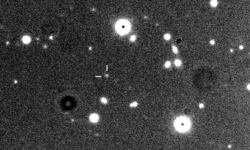Thyone (moon)
Topic: Astronomy
 From HandWiki - Reading time: 2 min
From HandWiki - Reading time: 2 min
 Discovery images of Thyone by the Canada-France-Hawaii Telescope in December 2001 | |
| Discovery[1] | |
|---|---|
| Discovered by | Scott S. Sheppard et al. |
| Discovery site | Mauna Kea Obs. |
| Discovery date | 11 December 2001 |
| Designations | |
Designation | Jupiter XXIX |
| Pronunciation | /θaɪˈoʊniː/[2] |
| Named after | Θυώνη Thyōnē |
| S/2001 J 2 | |
| Adjectives | Thyonean /ˌθaɪəˈniːən/[3] |
| Orbital characteristics [5] | |
| 20940000 km | |
| Eccentricity | 0.229 |
| Orbital period | −603.58 days[4] |
| Mean anomaly | 26.6° |
| Inclination | 148.5° |
| Longitude of ascending node | 243.0° |
| 89.1° | |
| Satellite of | Jupiter |
| Group | Ananke group |
| Physical characteristics | |
| Mean diameter | 4 km |
| Apparent magnitude | 22.3 |
Thyone /θaɪˈoʊniː/, also known as Jupiter XXIX, is a retrograde irregular satellite of Jupiter. It was discovered by a team of astronomers from the University of Hawaii led by Scott S. Sheppard in 2001, and given the temporary designation S/2001 J 2.[6][1]
Thyone is about 4 kilometres in diameter, and orbits Jupiter at an average distance of 21,605,000 kilometres in 603.58 days, at an inclination of 147.28° to the ecliptic (146.93° to Jupiter's equator) with an eccentricity of 0.2526. Its average orbital speed is 2.43 km/s.
It was named in August 2003 after Thyone, better known as Semele, mother of Dionysus in Greek mythology.[7]
Thyone belongs to the Ananke group, retrograde irregular moons which orbit Jupiter between 19.3 and 22.7 million kilometres, at inclinations of roughly 150°.
References
- ↑ 1.0 1.1 MPEC 2002-J54: Eleven New Satellites of Jupiter 2002 May (discovery and ephemeris)
- ↑ Noah Webster (1884) A Practical Dictionary of the English Language
- ↑ E. R. Gregory (1989) Milton and the Muses, p. 50;
Sidney Alexander (2016) The Complete Odes and Satires of Horace, p. 321 - ↑ "M.P.C. 104798". Minor Planet Circular. Minor Planet Center. 10 May 2017. https://minorplanetcenter.net/iau/ECS/MPCArchive/2017/MPC_20170510.pdf.
- ↑ S.S. Sheppard (2019), Moons of Jupiter, Carnegie Science, on line
- ↑ IAUC 7900: Satellites of Jupiter 2002 May 16 (discovery)
- ↑ IAUC 8177: Satellites of Jupiter, Saturn, Uranus 2003 August (naming the moon)
 |
 KSF
KSF
